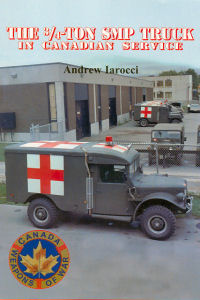
The 3/4 Ton SMP Truck in Canadian Service Book Review
By Cookie Sewell
| Date of Review | January 2010 | Title | The 3/4 Ton SMP Truck in Canadian Service |
|---|---|---|---|
| Author | Andrew Iarocci | Publisher | Service Publications |
| Published | 2009 | ISBN | 1-894581-56-1 |
| Format | 24 pages, softbound | MSRP (CDN) | $9.95 |
Review
Occasionally a book pops up in the excellent “Canada: Weapons of War” series about which I have more intimate knowledge than others. This is one as I first made my personal acquaintance with the Dodge M37 series trucks. Most of the ones in my unit in Vietnam were the M37B1 variant with internal modifications, but among US Army drivers the most obvious change was the driver’s side door mount for the spare tire (freeing up room for two more passengers in the rear compartment).
The “Three-Quarter” (all we ever called it) was slow but faithful and nearly impossible to destroy. Blessed with a semi-synchronized transmission it took care to shift, but was fairly nimble and ran well. My faith in one was shaken one night when, after taking personnel back to their barracks at 3 AM, I was returning to my work site when I passed a balcony with a bunch of ARVN (Vietnamese soldiers) having a party. One was weaving around (obviously very drunk) with an M1 carbine as I passed. Suddenly I hear a “pop pop pop” and bullets began to hit the truck. The first one went through the windshield in front of me, and the second behind my head; others were going through the rear canvas. I downshifted in a hurry to “Get the hell out of Dodge” when the rear driveshaft universal joint snapped and...it rolled to a halt.
Apparently this chap was trying to see if he could hit the white star on the passenger’s side of the truck. Another Vietnamese came over, screamed at him (nice to speak Vietnamese, as you know what’s going on!) “You idiot! That’s an American!” and then took the carbine away from drunk, butt-stroking him on the way. I shifted to low range (4WD) and drove back to my work site albeit slowly using the front axle drive. While the truck had failed me in my hour of need, it did get me back.
After much discussion in Canada as to how to replace its aging fleet of leftover WWII CMP Ford and Chevrolet light trucks (8 CWT and 15 CWT types) in 1950 the Canadian military decided to go with the US Army’s new M37 3/4 ton truck. This had a number of advantages: it was compatible with US Army vehicles so combat supply was assured; it met the primary load carrying requirements; and most important, it could be built in Canada at the Canadian Chrysler factory in Windsor, Ontario.
Between 1951 and 1955 the Canadian government bought 3,071 M37 cargo trucks for the Canadian Army and RCAF, 409 M43 ambulances (the legendary US Army “Crackerbox”) and one the US Army turned down – the M152CDN panel truck, of which they received 1,038. The latter was similar to the M43 but fitted out inside for use as a command or radio vehicle. (The US Army did not like the idea of dedicated vehicles in case of combat damage or replacement, so opted instead for the M37 fitted with removable shelters like the S-144 or S-250 types.)
The truck was referred to as an SMP vehicle - Standard Military Pattern - and all Canadian variants were flagged as “CDN” - e.g. M37CDN, M43CDN, and M152CDN. They mainly differed in that they used a larger engine (251 cid versus the T245 230 cid one) and a better transmission with three out of four gears synchronized versus only the top two on the US model.) The engines and transmissions were interchangeable so the Canadians could have swapped them in combat with American parts. Also, unlike US trucks which all had soft or canvas tops (the idea being you could remove them so the passenger could then rise up and shoot at aircraft, a dumb idea when one did the math) the Canadian ones were all fitted with insulated hardtops.
Most of the Canadian trucks paralleled their US counterparts with MWO changes (Modification Work Orders) but did not change designations when the US upgraded to the B1 variant nor differentiate between winch and non-winch equipped trucks.
Most of the cargo trucks left the Canadian inventory in the 1970s but the M152CDN remained until much later, and I recall seeing some still in service at CFB Kingston in 1994.
Overall this is a good little book and does an excellent job of describing the Canadian experience with the “Three-Quarter” to the general reader and military historian alike.
Thanks to Clive Law of Service Publications for the review copy.







